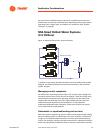
SYS-APM001-EN Chiller System Design and Control 27
System Design Options
There are many chilled-water-system design options; however, in a basic
sense, each option is a function of flow, temperature, system configuration,
and control. This section discusses the effect of flow rate and temperature
decisions.
It is important to remember that temperatures and flow rates are variables.
By judicious selection of these variables, chilled-water systems can be
designed to both satisfy chilled-water requirements and operate cost
effectively.
Chilled-water systems are often designed using flow rates and temperatures
applied in testing standards developed by the Air-Conditioning, Heating, and
Refrigeration Institute (AHRI), ARI 550/590–2003 for vapor compression
chillers and ARI 560–2000 for absorption chillers (see sidebar). These
benchmarks provide requirements for testing and rating chillers under
multiple rating conditions. They are not intended to prescribe the proper or
optimal flow rates or temperature differentials for any particular system. In
fact, as component efficiency and customer requirements change, these
standard rating conditions are seldom the optimal conditions for a real
system, and industry guidance recommends lower flow rates with resultant
higher temperature differences. There is great latitude in selecting flow rates,
temperatures, and temperature differences.
Selecting Chilled- and Condenser-Water
Temperatures and Flow Rates
Leaving chilled-water and entering condenser-water temperature selection
can be considered independently of their respective flow rates. However,
temperatures and flow rates should be selected together to design an
efficient and flexible chilled-water system.
Guidance for Chilled- and Condenser-Water Flow Rates
The ASHRAE GreenGuide
8
(pp 146-147) states:
In recent years, the 60% increase in required minimum chiller
efficiency from 3.80 COP (ASHRAE Standard 90-75) to 6.1 COP
(ASHRAE Standard 90.1-2004) has led to reexamination of the
assumptions used in designing hydronic media flow paths and in
selecting movers (pumps) with an eye to reducing energy
consumption… Simply stated, increase the temperature difference
in the chilled water system to reduce the chilled-water pump flow
rate…
The CoolTools™ Chilled Water Plant Design Guide recommends starting with
a chilled-water temperature difference of 12°F to 20°F [7°C to 11°C], and it
For more information, refer to ARI
Standard 550/590-2003, Performance
Rating of Water Chilling Packages Using
the Vapor Compression Cycle and the
ARI Standard 560-2000, Absorption
Water Chiller and Water Heating
Packages. Both are published by the Air-
Conditioning, Heating, and Refrigeration
Institute. www.ahrinet.org


















